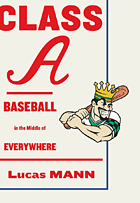Class A: Baseball in the Middle of Everywhere
Lucas Mann on hope and change in a minor-league-baseball city
There are thousands of young men on minor-league baseball rosters working toward a spot in the majors. Most of them won’t make it. With this in mind, essayist Lucas Mann spent the 2010 season in Clinton, Iowa, watching the city’s Class A team, the LumberKings. In his new book, Class A: Baseball in the Middle of Everywhere (Pantheon), Mann writes about becoming intimate with the players, the fans, and the town, and explores the themes of nostalgia, failure, and hope. I asked him six questions about his time in Clinton.
1. Much of Class A is about the belief in greatness, heroes, and perfection. How did these themes come to the fore when you were writing the book?
It grew out of watching what was happening on the field and in the town around me, and from listening to the ways different people tried to frame that reality. There’s something so instantly vivid about men on a baseball diamond, and so loaded with expectations, too, especially on a field like Clinton’s, which was built in the 1930s and carefully kept in that same dated, overblown aesthetic. It was unavoidable that I would start thinking about the gulf between the way we want things to be and the way they are. From a distance, the players look enormous and majestic, and then they run up to the dugout and you see, in some cases, teenagers who have no idea what they’re doing. Downtown Clinton, meanwhile, has the same picturesque facade it always had, but then you walk through it and see how many storefronts are empty, how few people are hanging out on these wide sidewalks that were made for foot traffic.
But I don’t want it to seem like I’m in any way skewering ideas of greatness or perfection. Over the course of the season, I came to be amazed by the collective resilience of people pushing to see greatness, to see transcendence all around them. Whether it was players who needed to feel closer to the majors than they were, or fans making the games they were watching feel consequential, there was this conscious inflating of everything that was happening. There’s nothing more human or relatable than that effort. I got swept up in it.
From Class A:
I want to tell Hank that I’ve been thinking about the term “nostalgia,” how I learned that it originated when a graduate student mixed the Greek words nostos, “return to the native land,” with algos, “suffering grief.” I want to tell him that it was born to describe mercenaries who traveled Europe for a job until they weren’t sure what they missed, that it was classified as fatal. I want to ask him, isn’t that crazy, Hank? To die from wanting to return. I want to tell him that I miss things that were never mine, want to return to a place, more of a feeling, that never really existed, and doesn’t baseball always promise that there was once something purer?
2. Why not write this book as pure journalism? Why insert your own story?
So much of how I write is wrapped up in voice. I write personally; that’s how it comes out. I like essays and nonfiction that try to do a lot of things at once, that investigate and report on subjects but never shy away from showing how all that observation affects them. I’m terrified of omniscience, both as a writer and a reader. Lawrence Weschler, the great New Yorker writer, has a quote along the lines of, “I like to insert a strong I into what I’m writing not out of some sense of egomania, but precisely the opposite.” I agree with that. I don’t have the hubris to traditionally report on something, then step back, remove my personality, biases, memories, and screw-ups, and speak with authority. I’m the neurotic, often-confused dude who is trying to figure out why all this stuff is important to him, and that crucial, intimate honesty isn’t something I’d ever want to remove from the work.
3. Joyce, a fan who obsessively collects team memorabilia, is a powerfully sympathetic character in this book. Why was she important?
Early on in the book, I write that I hadn’t planned for the fans and their interests to be central to the narrative, and that’s true. It didn’t even seem like an option. With the exception of A Fan’s Notes, all of the sports literature I’ve read, both fiction and nonfiction, treats fans as fuzzy background filler, or as a monolith reacting in unison to the exploits of important characters. But Joyce was just so present, so alive and unique, that she pushed her way into the story. She was always at games, a really kind, easy-to-talk-to person who was unabashedly unique and invested in the things she wanted to be invested in.
Players came and went, as did coaches — in a place like Clinton, the town’s allegiance to major-league teams shifts over the years as well. But Joyce was constant, snatching up home-run balls at batting practice, collecting signatures from every player who arrived, sitting in her same seat hollering cheers. She made each game and player matter for her. She collected artifacts, wrote stories about players, traveled to away games to make sure there was a Clinton presence in the bleachers. She did these things on her own, making a crucial role for herself in the minor-league ecosystem. As a writer, I’m drawn to the ways people try to create meaning in their lives, and so Joyce’s effort and belief gripped me.
4. You write in the book about cycles, ebbs and flows, seasons of growth and withering. What long-term hope do you ultimately find in these motions?
Well, that’s what’s so comforting about sports. The season starts, then it ends, and we can be sure it will start up again at the same time next year. That sense of rebirth has always felt very powerful to me. In the autobiographical thread of the book, that feeling, that need for constancy, is there for both my father and myself. And then I met these fans who have been following their team’s cycle for decades, this one constant in the face of job loss, population loss, all of this erratic change. It infused the stands with a sense of deep investment and continual possibility, like the fans were creating a space to remanufacture hope. I was also captivated by my daily drive through the cornfields — the changing height and color of the endless rows progressed along with the baseball season, and seemed like the perfect physical manifestation of the rhythms that we all fell into with the game. It’s no great revelation, but I loved dropping down and capturing the intimacies of one season of minor-league baseball — a triumphant at bat, a conversation in the stands that makes everyone laugh — amid a world that will just keep right on moving.
5. Your book also covers the culture’s demand that young ballplayers sacrifice themselves for a dream. Why is this vision of big-league success so powerful and costly?
There’s something appealing and particularly American about the idea of earning things in the hardest possible way. And sports narratives certainly latch onto that idea. There has to be something to overcome, which then allows us to love an athlete for his or her success because we can assert that the athlete deserves it. That was part of what made the minor-league world seductive for me: the chance to witness the difficult moments in a player’s journey toward triumph.
But I started to notice how that storyline had set up this grinding, undefeatable set of circumstances for many players, who were sacrificing without a real chance to reap the benefits. In the book, I end up asking “Why?” a lot. Why keep working so hard when the odds are unfairly stacked against you? Why is this worth it? The players and coaches — everyone in the minor leagues — wrestle with these ideas every day and find their own justifications to keep going.
 6. The book begins by focusing on the team as a whole, then zooms in on specific players and fans. Why did you use this technique?
6. The book begins by focusing on the team as a whole, then zooms in on specific players and fans. Why did you use this technique?
In a very basic sense, the structure reflects my search for emotional hooks: the specificity of an image like Erasmo Ramirez making dinner adds a very human element to the general idea of what minor-league life is like. I very literally imagined someone looking from behind a camera, scanning, scanning, trying to find moments, images, and people, then focusing the lens on them; while I was researching, I was keeping my eyes open until a subject became so vivid, so fascinating, that I had to zoom in.
I tried to be as open as possible throughout, because I’m excited by books that seem willing to go where the author’s curiosity takes them. The constant modulation between larger issues and intimate portraits creates the sense that small, unexpected stories can have huge significance.






